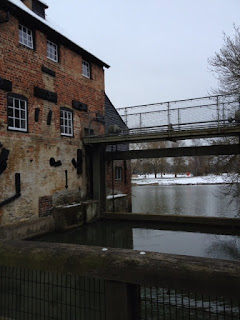A mill has stood on the river Ouse at Houghton since at
least 969. That was the year Ramsey Abbey was granted the right to put up a
mill, and demand that local farmers use it for making flour. It continued in
use as a mill until 1929, when commercial operations came to an end. But the
local people loved it so much as a landmark and picturesque spot that they came
together to save it from disappearing. The building was, for many years, a
youth hostel, albeit, from 1939, in the ownership of the National Trust.
 |
| Houghton Mill, January 2013 |
In 1998 substantial new investment was made in the site
thanks to the Heritage Lottery Fund. A new mill wheel was added, and additional
land and buildings purchased. Houghton Mill now welcomes many thousands of
visitors each year, who come to see a working water mill in operation as well
as enjoy the open meadows and river banks nearby.
 |
| The mill wheel, added as part of an HLF-funded Millennium project |
When I visited this week, I had the great pleasure of being
able to turn the handle that opened the sluice gate and started the mill wheel turning.
It was a magical experience. I could physically feel the power of the water
rushing through, adding resistance to the handle’s turn and starting to shake
the timbers of the building. Flour soon started pouring out, and Steve, visitor
services manager, explained how the different settings produced different
grades of flour.
 |
| Steve at Houghton, showing me how the mill works |
Sandy, a volunteer who works at the site, also showed me the
secondary motor and mill stone that has been installed. This is a back-up, to
ensure that flour can still be ground on days when the water levels prevent the
main wheel from being used. As Phil, ops
manager, knows all too well, visitors to the mill above all want to see it in
action.
My visit made me reflect on how our approach to industrial
heritage differs from our attitudes to other sorts of heritage. A mill is a
mill, regardless of the age of its individual components. The main building at
Houghton today dates from the second half of the 18th century,
with plenty of later additions.
 |
| Houghton, as shown on an early OS map |
The team shared lots of conservation dilemmas with me: how
to differentiate (or not) new woodwork from the existing timbers, how to manage
visitor flows in some very tight and compact spaces. But the idea of installing
new mill stones feels inherently right, even if those mill stones are not
‘original’. (Actually the new stones are French burr stones, manufactured by
Kay & Hilton in Liverpool in 1859.)
I suppose Houghton Mill is therefore the Trust’s own version
of Trigger’s Broom:
how many times can you change the handle and head of a broom before it ceases
to be the same broom? (Philosophers apparently refer to this as Theseus’ Paradox, after a story retold by Plutarch, so
it’s not exactly a new conundrum.)
Anyway, the visit also reminded me of the power of bringing
places to life. The mill really is a mill, producing flour from the natural power
of the river’s flow. Phil and his team know that bringing Houghton to life means keeping the
mill working. What’s more, I was delighted to be given a bag of Houghton flour,
which I was able to take home as a memento. I am pleased to say it became some
very tasty bread the next day.
 |
| Before |
 |
| After |
I cheated and used a breadmaking machine. But it’s still
bread, as Trigger (or Plutarch) might have pointed out.
No comments:
Post a Comment